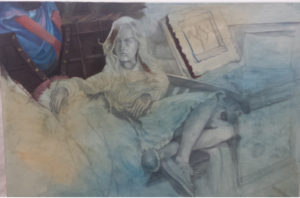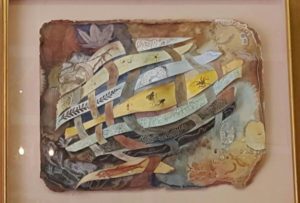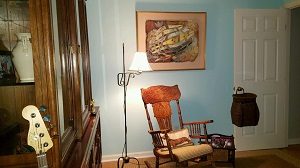Some painters bore me to tears with their talk of products. This is no reflection on them, you understand. It simply means it’s hard enough for me to focus on my paintings, the colors, the color mixes, temperature, chroma, ohmigosh–and really, ideas, symbols of my own, composition, magic, aura, and a few other semi-important things.
Not to say that materials are not important; I would not insult my materials mentors/gurus in such a way. I need them too much to do the work for me that drives me batty. Even when I draw what seem to be iron-clad, irresistible, case-closed conclusions out of the principles they give, I sometimes miss. Usually, that’s because there’s a missing product that my logic did not consider, hidden in the mix. For that reason, I’m gong to explore a fairly simple product, one that doesn’t chemically change a hundred times in the space of putting it on my palette, mixing it, adding turpentine or mineral spirits or 101 other additives, getting it on the canvas, and allowing it to gently (we hope) age. Inside, not outside.
What in the world? I hope you are asking.
My new paint brushes, that’s what! Both the watercolor, water-media ones and the made-for-oil brushes are among the best I have ever used. I ‘afforded’ them when my favorite art supply retailer went out of business. Basically, this is overview, since I am including both the watercolor media and the oil painting media within my comments.
Here is a watercolor I finished using them almost exclusively, adding the occasional slightly more candletip-shaped watercolor brush. The slight more control helped me complete the linear look of this textured house while broadening the stroke into wet, wider shapes without a change of brush. 
Which brand it it? you ask, dying to know by now.
“Grey MattersTM” by Jack Richeson. First of all, the color of the brushes is outstanding. The color whispers quality, class. That first impression doesn’t let you down, either, among this cluster of mostly long-handled brushes. The shaft is easy to hold, its texture a soft matte which doesn’t peel off like some of the lacquered brushes. The bristles are thick, sensitive to nuance, and yet, not floppy, like some very good brushes I have and have used in watercolor. This makes for easy, wet control, not dry, single-hair control: what I call THE difference in expert watercolors and simply nice ones.
As a European classical watercolorist, I have tended to buy no flats, as they control watercolor flow way too much. I use them now primarily for edges, sliding the straight edge along a straight passage to get a single stroke edge with wet watercolor. In this brand, however, I bought filberts, flats, rounds, shaders–every conceivable shape, simply because I could. I have to say the RichesonTM flats and filberts do not over-control watercolor flow. Nor does medium damage or alter the brush hairs when working in oils. Simply put, in opposing media usage, they hold their shape equally well. They allow for nuanced strokes and color additions. The natural-looking bristles are grey-brown, as well, and simply put, the best synthetic I have ever put to paper or canvas.
You probably got it–I am buggy over these brushes. Thanks, Jack Richeson GreyMattersTM.
This is an oil painting of mine in progress. I feel the canvas and first paint layer literally glows in welcome to the strokes from these brushes. 
I am about to buy some of their Quiller Synthetic Watercolor brushes, too. Their ad copy says what I have been saying about their other line: ‘truly advanced synthetic brushes.’ It seems they are designed by a renowned water media painter, Steve Quiller. “Years ago, synthetic brushes were not much more than chopped up fishing line bundled up and stuck on the end of a handle. They were horrible for the user, especially for the young student who often received this budget-priced creation.” Yes, I agree.
Richeson discovered a way to taper fiber strands so each strand comes to a fine point. He selects 11 different weights of fiber strands, creatively mixing them into “a marvelous brush head.” Mixing weights makes the difference in getting the snap back you need, a solution to the floppy, sloppy brush, as I call it.
Here’s one happy painter. Some days your choices get you singing someone else’s praises. And that’s snap back for you, too. Check out the finished product: http://paintings.joriginals.net/product/grooves/
Learn more »
 kept looking at the painting before deciding they had to have it. David helped get it down from the second story portion of my gallery/atelier. Now it hangs in David’s study in his new home in Pinehurst. Although a color match was not a primary concern, the effect was striking.
kept looking at the painting before deciding they had to have it. David helped get it down from the second story portion of my gallery/atelier. Now it hangs in David’s study in his new home in Pinehurst. Although a color match was not a primary concern, the effect was striking.